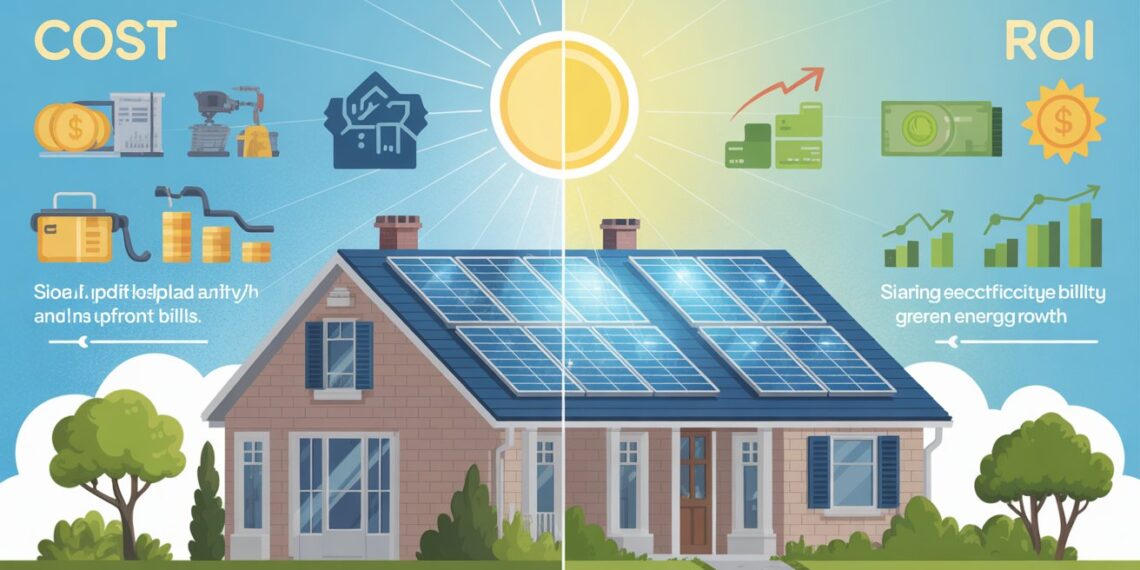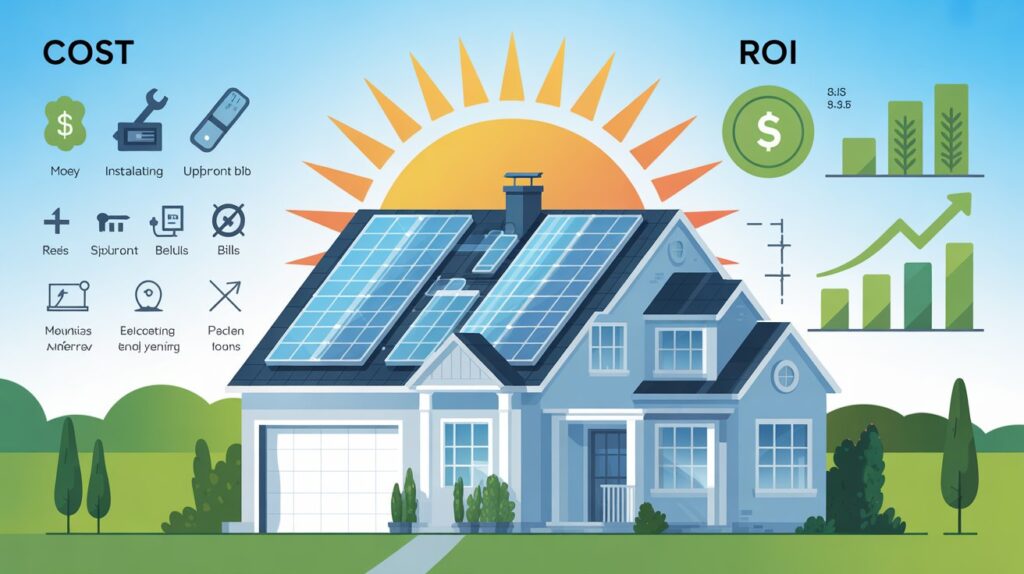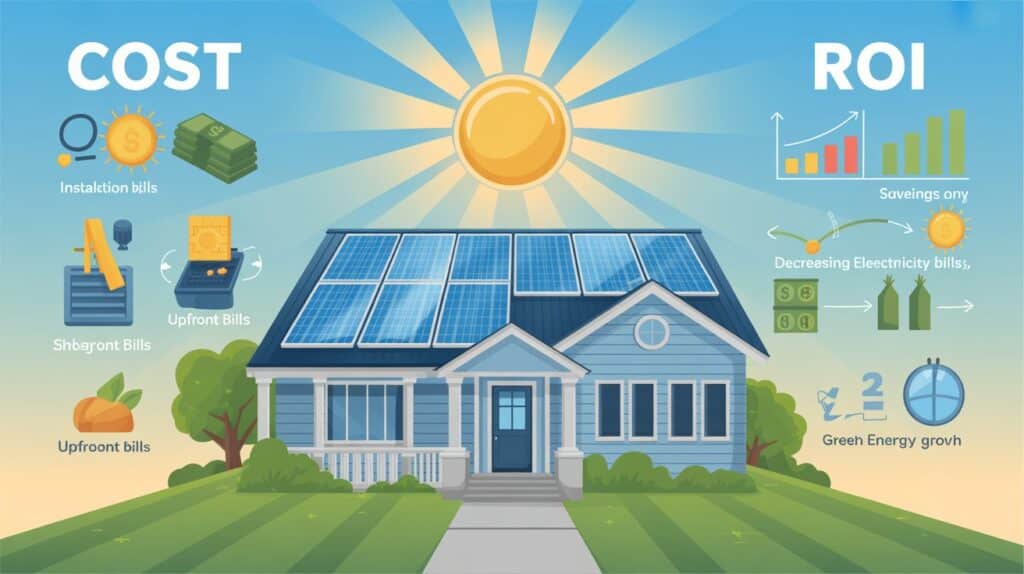Over the last decade, solar energy has transformed from a futuristic option to a mainstream reality for homeowners. Rising electricity rates, increasing awareness of climate change, and supportive government incentives have driven more households than ever to consider making the switch. But one critical question always comes up: What is the real balance between the cost of installing solar panels for homes and the return on investment (ROI)?
Understanding this balance is essential. On one side, you face an upfront investment that can range into tens of thousands of dollars. On the other, you gain decades of lower utility bills, energy independence, and potentially thousands of dollars in lifetime savings. In this in-depth guide, we’ll break down Solar Panels for Homes: Cost vs. ROI, exploring installation expenses, incentives, payback periods, and strategies to maximize returns in 2025 and beyond.
The Current Cost of Solar Panels in 2025
The cost of solar systems has fallen by more than 60% since 2010, but it still represents a significant financial decision for households. Let’s break down the elements that make up total system cost.
System Size and Pricing
Solar systems are sized in kilowatts (kW), with the average U.S. home requiring between 6 and 10 kW depending on energy consumption.
-
Small homes (4–6 kW): $11,000–$20,000 before incentives
-
Medium homes (7–10 kW): $18,000–$30,000
-
Large homes (11–15 kW): $28,000–$45,000
The average price per watt in 2025 ranges from $2.75 to $3.25. A 10 kW system, for example, would cost roughly $27,500–$32,500 before tax credits.
Equipment Costs
-
Solar panels: These account for 30–40% of system costs. Higher-efficiency panels cost more but generate greater output per square foot.
-
Inverters: Necessary to convert DC electricity into usable AC power. String inverters are cheaper; microinverters cost more but optimize each panel individually.
-
Batteries: Optional but valuable for energy storage and backup. Adding a battery can increase system costs by $7,000–$15,000.
Labor and Installation
Labor, permitting, and overhead typically make up 10–20% of costs. This includes site surveys, structural engineering, and compliance with local regulations.
Incentives and Tax Credits
The federal Investment Tax Credit (ITC) remains the most significant incentive, offering a 30% reduction on system costs for installations completed before December 31, 2025. Additional state-level rebates, Solar Renewable Energy Certificates (SRECs), and utility-specific incentives can bring costs down further.
Example:
-
8 kW system = $24,000 upfront
-
Federal ITC (30%) = –$7,200
-
State rebate = –$2,000
-
Net cost = $14,800
ROI: How Solar Panels Pay You Back
ROI measures the financial return you receive compared to your investment. For solar panels, ROI primarily comes from savings on electricity bills.
Payback Period
The payback period is the number of years it takes to recover installation costs through energy savings.
-
Best case (ideal sunlight, high electricity costs, cash purchase): 5–7 years
-
Average U.S. homeowner: 8–12 years
-
Less favorable conditions: 12–15 years
Long-Term ROI
Since solar panels often last 25–30 years, homeowners typically enjoy 15–20 years of free or nearly free electricity after breaking even.
Example Calculation:
-
Net cost after incentives: $18,000
-
Annual energy savings: $1,800
-
Payback period: 10 years
-
Savings over 25 years: $45,000
-
Net ROI: 150%
Annual ROI Percentage
Solar panels generally yield 8–12% annual returns, making them competitive with traditional investments like stocks and bonds—but with the added benefit of lowering household expenses.
Key Factors Influencing ROI
Not every household experiences the same ROI. Several variables play a role:
Electricity Rates
Areas with high utility costs (California, Hawaii, New York) yield faster payback, while states with lower rates see slower returns.
Roof Orientation and Condition
South-facing roofs with little shading maximize energy generation. Roofs in poor condition may require upgrades before solar installation, adding to initial costs.
Net Metering Policies
Net metering allows homeowners to sell excess electricity back to the grid, further boosting ROI. However, some states are reducing or phasing out these policies, which can lengthen payback periods.
Financing Options
-
Cash Purchase: Best long-term ROI; no interest payments.
-
Solar Loans: Spread costs out but extend payback. Interest reduces lifetime ROI slightly.
-
Leases and PPAs: Require little or no upfront cost, but you don’t own the system, so ROI is limited.
Incentives and Rebates
State-level rebates, SRECs, and local incentives can reduce payback periods by years. Always research what’s available in your region.
Regional Variations in Solar ROI
Solar ROI varies widely depending on location:
-
California, Arizona, Nevada: Payback in 5–7 years thanks to abundant sun and high utility costs.
-
Northeast (Massachusetts, New Jersey, New York): Payback in 7–10 years, helped by strong state incentives despite variable weather.
-
Midwest and South: Payback in 10–12 years due to moderate sunlight and electricity rates.
-
Pacific Northwest: Payback in 12+ years, but still financially beneficial over a system’s lifespan.
Financing Solar Panels: Which Option Makes Sense?
Cash Purchase
-
Highest upfront cost.
-
Fastest payback and best ROI.
-
Eligible for full incentives and rebates.
Solar Loan
-
No upfront cost beyond small fees.
-
Interest slightly reduces ROI.
-
Popular for homeowners who plan to stay in their homes long-term.
Lease / Power Purchase Agreement (PPA)
-
Low or zero upfront cost.
-
Savings appear immediately.
-
Homeowner does not own system, limiting ROI and property value benefits.
New Subscription Models
Emerging companies offer subscription-based solar, allowing homeowners to access solar energy without upfront payments. These models trade ownership for convenience, appealing to households that want instant savings.
Case Study: A 10 kW System in Three Different States
California
-
Cost before incentives: $30,000
-
Federal ITC: –$9,000
-
State rebates: –$1,500
-
Net cost: $19,500
-
Annual savings: $2,500
-
Payback: 8 years
Texas
-
Cost before incentives: $28,000
-
Federal ITC: –$8,400
-
State rebates: $0
-
Net cost: $19,600
-
Annual savings: $1,700
-
Payback: 11.5 years
Massachusetts
-
Cost before incentives: $29,000
-
Federal ITC: –$8,700
-
State incentives: –$3,000
-
Net cost: $17,300
-
Annual savings: $2,000
-
Payback: 8.5 years
Maximizing ROI
-
Install before the federal ITC expires in 2025.
-
Choose high-efficiency panels to get more output from limited roof space.
-
Pair with batteries to save on peak-time utility charges.
-
Improve home energy efficiency before installing solar to reduce system size needs.
-
Shop multiple installers to compare quotes and financing options.
FAQs
How much do solar panels for homes cost in 2025?
Between $15,000 and $40,000 before incentives, depending on system size and location.
How long is the payback period?
On average 8–12 years, though some homeowners see payback in as little as 5 years.
What is the average ROI?
Most homeowners see 8–12% annual ROI over the system’s life.
Do solar panels add home value?
Yes. Homes with solar often sell for 4–5% more and tend to sell faster than those without solar.
What happens when the ITC expires?
Unless extended, the ITC will drop after December 31, 2025, making solar more expensive for new buyers.
Do solar panels require maintenance?
Minimal maintenance is required. Most systems only need occasional cleaning and annual inspections.
Can I go completely off-grid with solar?
Yes, but you’ll need a larger system and substantial battery storage, which increases costs. Most homeowners remain grid-tied for reliability.
Conclusion
When weighing Solar Panels for Homes: Cost vs. ROI, the long-term financial benefits are clear. While upfront costs in 2025 remain substantial, incentives like the 30% federal tax credit significantly reduce the burden. Typical payback periods fall between 8 and 12 years, after which homeowners enjoy decades of savings.
For many households, solar panels represent not just an eco-friendly choice but also one of the smartest financial investments available. With rising energy costs, supportive incentives, and technology that continues to improve, there has never been a better time to consider going solar.
The bottom line: If your home is suitable for solar, installing panels in 2025 means locking in savings, boosting property value, and achieving energy independence for the next 25 years or more.













